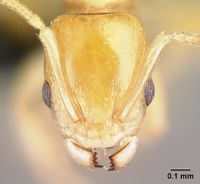Nesomyrmex flavus
| Nesomyrmex flavus | |
|---|---|

| |
| Scientific classification | |
| Kingdom: | Animalia |
| Phylum: | Arthropoda |
| Class: | Insecta |
| Order: | Hymenoptera |
| Family: | Formicidae |
| Subfamily: | Myrmicinae |
| Tribe: | Crematogastrini |
| Genus: | Nesomyrmex |
| Species group: | madecassus |
| Species: | N. flavus |
| Binomial name | |
| Nesomyrmex flavus Csösz & Fisher, 2016 | |
This species is known to occur in Madagascar’s rain forests at high altitudes between 200 and 1755m, mean: 1190m. This species is known to forage in low vegetation and nests can often be found in dead twigs. This species has occasionally been collected in leaf litter (leaf mold, rotten wood), or in rotten tree stumps.
Identification
A member of the madecassus species-group.
Csősz & Fisher (2016) - Workers of N. flavus cannot be confused with Nesomyrmex gibber because the conspicuous mesothoracic hump which is a diagnostic character of the latter species is absent in N. flavus workers. This species can be easily separated from dark phenotypes of Nesomyrmex madecassus by color: the dark madecassus phenotypes are dark brown but the workers of N. flavus are light yellow. Morphometric ratio (PoOC/CW) and discriminant D4 function helps to separate N. flavus from ocher madecassus phenotypes.
The workers of this species are the most similar to that of Nesomyrmex nitidus. The elevational distribution of the two species may provide hints useful for separation but the ranges broadly overlap. These taxa represent true cryptic species which cannot be identified based on qualitative characters (i.e. sculpture, shape or color), and their overlapping range means ratios cannot be used for identification. Therefore, only a discriminant D2 function with a greatly reduced character set yields complete separation.
Keys including this Species
Distribution
Latitudinal Distribution Pattern
Latitudinal Range: -13.26333° to -24.76389°.
| North Temperate |
North Subtropical |
Tropical | South Subtropical |
South Temperate |
- Source: AntMaps
Distribution based on Regional Taxon Lists
Malagasy Region: Madagascar (type locality).
Distribution based on AntMaps
Distribution based on AntWeb specimens
Check data from AntWeb
Countries Occupied
| Number of countries occupied by this species based on AntWiki Regional Taxon Lists. In general, fewer countries occupied indicates a narrower range, while more countries indicates a more widespread species. |

|
Estimated Abundance
| Relative abundance based on number of AntMaps records per species (this species within the purple bar). Fewer records (to the left) indicates a less abundant/encountered species while more records (to the right) indicates more abundant/encountered species. |

|
Biology
Castes
Worker
Images from AntWeb
   
| |
| Worker. Specimen code casent0121813. Photographer Erin Prado, uploaded by California Academy of Sciences. | Owned by CAS, San Francisco, CA, USA. |
   
| |
| Worker. Specimen code casent0189276. Photographer Erin Prado, uploaded by California Academy of Sciences. | Owned by CAS, San Francisco, CA, USA. |
   
| |
| Worker. Specimen code casent0227040. Photographer Erin Prado, uploaded by California Academy of Sciences. | Owned by CAS, San Francisco, CA, USA. |
Nomenclature
The following information is derived from Barry Bolton's Online Catalogue of the Ants of the World.
- flavus. Nesomyrmex flavus Csősz & Fisher, 2016: 115, figs. 4-6 (w.q.m.) MADAGASCAR.
Unless otherwise noted the text for the remainder of this section is reported from the publication that includes the original description.
Description
Worker
Body color: yellow. Body color pattern: Body concolorous. Absolute cephalic size: 602 [533, 699]. Cephalic length vs. Maximum width of head capsule (CL/CWb): 1.26 [1.19, 1.36]. Postocular distance vs. cephalic length (PoOc/ CL): 0.48 [0.46, 0.50]. Postocular sides of cranium contour frontal view orientation: converging posteriorly. Postocular sides of cranium contour frontal view shape: convex. Vertex contour line in frontal view shape: straight; slightly concave. Vertex sculpture: main sculpture inconspicuous, ground sculpture smooth. Gena contour line in frontal view shape: convex. Genae contour from anterior view orientation: converging; strongly converging. Gena sculpture: Concentric carinae laterally surrounding antennal foramen: present. Eye length vs. absolute cephalic size (EL/CS): 0.25 [0.23, 0.27]. Frontal carina distance vs. absolute cephalic size (FRS/CS): 0.30 [0.28, 0.32]. Longitudinal carinae on median region of frons: present. Longitudinal carinae on medial region of frons shape: variable. Smooth median region on frons: present. Antennomere count: 12. Scape length vs. absolute cephalic size (SL/CS): 0.80 [0.76, 0.83]. Median clypeal notch: variable. Ground sculpture of submedian area of clypeus: present. Median carina of clypeus: absent. Lateral carinae of clypeus: present. Metanotal depression: variable. Dorsal region of mesosoma sculpture: fine areolate ground sculpture, superimposed by dispersed rugae. Lateral region of pronotum sculpture: areolate ground sculpture, main sculpture dispersed costate. Mesopleuron sculpture: fine areolate ground sculpture, superimposed by dispersed rugulae. Metapleuron sculpture: fine areolate ground sculpture, superimposed by dispersed rugulae. Petiole width vs. absolute cephalic size (PEW/ CS): 0.22 [0.21, 0.24]. Anterior profile of petiolar node contour line in lateral view shape: concave. Dorso-caudal petiolar profile contour line in lateral view shape: convex; strongly convex. Dorsal region of petiole sculpture: ground sculpture smooth, main sculpture absent. Postpetiole width vs. absolute cephalic size (PPW/CS): 0.35 [0.33, 0.40]. Dorsal region of postpetiole sculpture: ground sculpture smooth, main sculpture dispersed rugose; ground sculpture smooth, main sculpture absent.
Type Material
Holotype: CASENT0393113, collection code: BLF36563: Madagascar, Prov. Toliara, Anosy Region, Anosyenne Mts, 31.2 km NW Manantenina, N -24.13894, E 47.06804, alt 1125 m, B.L. Fisher, F.A. Esteves et al., 2_26_2015, (1w, California Academy of Sciences). Paratypes: Five workers, four gynes and two males with the same label data with the holotype under CASENT codes: CASENT0393110, collection code: BLF36563 (1w, 1q, CASC); CASENT0393111, collection code: BLF36563 (1w, 1q, CASC); CA-SENT0393112, collection code: BLF36563 (1w, 1q, CASC); CASENT0393113, col-lection code: BLF36563 (1q, CASC); CASENT0393114, collection code: BLF36563 (1w, 1m, CASC); CASENT0393115, collection code: BLF36563 (1w, 1m, CASC)

